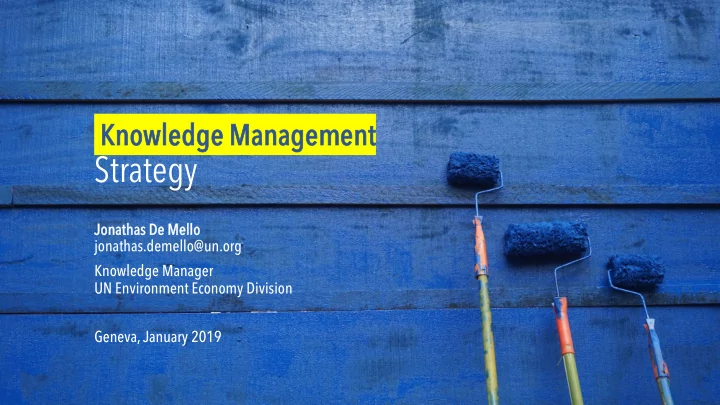

Knowl wledge Management Strategy Jo Jonath thas De De M Mello jonathas.demello@un.org Knowledge Manager UN Environment Economy Division Geneva, January 2019
Knowl wledge Management Strategy Items of this session: 1 About Knowledge Management 2 Strategy 3 People: stakeholders and personas 4 Knowledge-based outputs, tools and processes
1/4: About Knowledge Management | not a website A website is just one out of the several tools that can be used to collect and What is disseminate knowledge. not an isolated activity NOT Knowledge management is interdisciplinary. knowledge It will require constant exchange with both management components and other project management areas such as monitoring, reporting, communications, etc. not an immutable rulebook Knowledge management is a dynamic discipline that is constantly being rethought, experimented, and questioned to consider complexity and diversity of knowledge.
1/4: About Knowledge Management | Knowledge Management is a discipline that can better manage the flow between tacit (implicit) and explicit knowledge SECI Spiral of Knowledge model, Nonaka and Takeuchi
1/4: About Knowledge Management | In practice:
2/4: Knowledge Management Strategy| 2. Strategy: from knowledge to action
2/4: Knowledge Management Strategy| The Knowledge Management Strategy plans to better create, identify, document, strengthen, and disseminate knowledge-intensive activities to 2020 and beyond. This strategy proposes an evidence-based mechanism to improve the management of chemicals.
2/4: Knowledge Management Strategy| Great attention will be given to strengthening existing successful knowledge-intensive activities within stakeholders, so keep us informed of what you’re doing. Any technological output will be people-centered, aimed at solving problems faced by implementers and beneficiaries, instead of creating additional burdens.
This strategy is anchored into the groups of people involved in the project, how they behave, what they need and prefer. 3. PEOPLE in the center
3/4: People| We propose two methods to better understand who are the ones to be involved in knowledge activities: A: A: Mapping of sta stakeholders s - En Entity lev evel el B: B: Identifi fication of personas – Ind Individua ual level
3/4: People| A. Mapping of stakeholders - Entity level Four main groups of stakeholders were identified, with corresponding beneficiaries of project activities: Government • National governments, regulators, governmental agencies, NCPCs… (what else?) Industry • SMEs, industry associations… (what else?) Civil society • NGOs, academia, press, consumer associations…. (what else?) Intergovernmental Organisations • WHO, FAO, OECD… (what else?) Feedback we're looking for: Are those groupings accurate? Is there any subgroup (beneficiaries of project activities) missing or misplaced? Please feel free to write over the notes and rearrange as appropriate
3/4: People| B. Identification of personas – Individual level The portraits displayed identify main target groups and describes them as individuals. It helps creating reliable and approachable representations of the key stakeholders. It aims to: • Represent major target groups, its needs and expectations • Suggest how they're likely to interact • Describe real people with backgrounds, goals, and values • It is not intended to represent all the audiences or to address all needs. It focuses on major needs of the most important user groups. • This exercise cannot be too precise to avoid restricting profiles, neither too broad to avoid losing focus. Feedback we're looking for: Is there any persona/target group missing? Is there any inconsistency in any persona? Please write directly in the portraits your suggestions and ideas to better profile
4/4: Knowledge-based outputs, tools and processes | 4. Knowledge-based outputs, tools and processes | Some knowledge-based outputs, tools and processes were identified as alternatives to support the implementation of this strategy, based also in the project design. These can be developed from scratch, built upon existing alternatives, or combined:
4/4: Knowledge-based outputs, tools and processes | Knowledge-based outputs, tools and processes • Identification and creation of documents that link the chemicals agenda with SDGs • Databases of: • Multimedia resources • EPI experts (and networks of experts) • EPI monitoring and SAICM implementation progress • Data visualization tools (maps, charts) • Communities of practice (identification of active communities and/or development of new ones) • Survey tools to gather feedback on the knowledge strategy design and progress, aiming to identify gaps and opportunities to strengthen knowledge flows. • Collaborative calendar with user-input events • Communications strategy aligned to this knowledge strategy • Innovative approaches to knowledge management such as big data, artificial intelligence, gamification, virtual reality
4/4: Knowledge-based outputs, tools and processes | Knowledge-based outputs, tools and processes - continued • Processes to: • identify, attend and present at relevant meetings • promote media cross-posting and media uptake among partners • engage and encourage partners to provide knowledge (SAICM OEWG3 and ICCM5) • promote EPIs by facilitating networking, knowledge exchange and partnership among stakeholders through the component deliverables • encourage project partners to give technical input to write stories on key EPIs, new reports, upcoming meetings, assessment of progress, and/or new decisions and recommendations related to chemicals management (in collaboration with IISD) • evaluate, select and up-scale best practices for countries, SAICM stakeholders and a wider audience working on sound management of chemicals • analyze access/download of resources and user interaction in SAICM platforms and in its partners’ platforms to identify trends
4/4: Knowledge-based outputs, tools and processes | Which other knowledge-based outputs, tools and processes do you suggest?
Sailboat exercise At the end of this process we should have identified tangible outputs such as successful existing outputs, problems and alternatives to solve these problems
Please keep in touch for exchanging ideas on how to improve knowledge: jonathas.demello@un.org
Recommend
More recommend